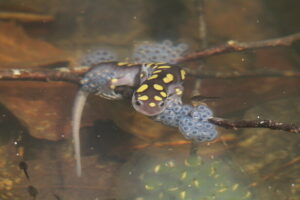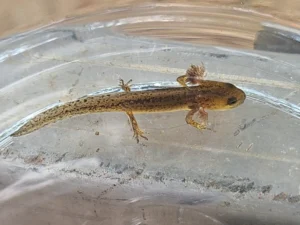If you’ve ever seen a salamander slip quietly across a wet log or disappear into the leaves by a stream, you’ve probably wondered about its secret little life. With their smooth skin and hidden ways, salamanders keep a lot to themselves. One question people often ask is simple: do salamanders have genders?
Yes, salamanders do have genders. Like most animals, salamanders usually come as male or female. Males make sperm, females lay eggs, and together they create the next generation.
But as with most things in nature, the details get more interesting the closer you look.
How Do We Know Salamanders Have Genders?
Scientists have studied salamanders for years and found that they reproduce sexually. That means a male’s sperm has to meet a female’s eggs.

In many species, the two sexes look a little different, especially during breeding season.
Males might grow bigger tails, brighter colors, or special glands that help them hold onto females. These differences are called sexual dimorphism.
Sometimes it’s obvious, sometimes it’s so subtle you’d only notice it if you were studying them closely.
Male vs. Female: What’s the Difference?
The exact differences depend on the species, but here are some of the common ones:
- Size: In some salamanders, females grow larger. In others, the males do.
- Color: Males often show brighter colors during breeding season.
- Features: Some males grow pads on their feet or glands on their body to help during mating.
- Tails: Males sometimes have longer or more colorful tails.
Outside of breeding season, though, it can be very hard to tell the genders apart.
How Do Salamanders Reproduce?
Salamanders don’t reproduce exactly like mammals or birds. Instead, they use a mix of methods.
In many species, females lay eggs in water or damp places, and males release sperm over the eggs to fertilize them. That’s called external fertilization.

But some species do it differently. Males will leave little packets of sperm called spermatophores on the ground or in the water.
The female picks one up with her cloaca (an opening for both reproduction and waste), and fertilization happens inside her body.
Do Salamanders Ever Change Gender?
For the most part, no. Salamanders are either male or female for life. Unlike some fish that can switch sexes, salamanders usually stick with the gender they were born with.
There are rare cases of amphibians where environment plays a role, but salamanders don’t normally change gender.
Are There Salamanders Without Males?
Here’s where things get really surprising. A few salamander species can reproduce without males at all.
This process is called parthenogenesis, and in these cases, the population is made up entirely of females.

They produce clones of themselves, so the babies are basically genetic copies of their mothers.
It’s handy for survival when males are nowhere around, but it doesn’t create much genetic variety.
Why Does Gender Matter?
Having males and females allows salamanders to mix their genes. This mixing creates variety in the population, which helps them survive changes in the environment.
For example, it might make them stronger against diseases or better able to live in new habitats.
How Do Salamanders Find Mates?
Since many salamanders live in dark, damp places, they don’t rely much on sight. Instead, they use chemical signals called pheromones.
Males may release pheromones to attract females or to warn off rivals. During breeding season, salamanders often travel to ponds, streams, or wetlands.
Males show off with bright colors or even little dances to get a female’s attention.
What About Species That Look Alike?
In species where males and females look almost the same, they rely more on behavior and scent.
Males may get more aggressive, more active, or move around more during mating season.
Scientists sometimes have to look inside the salamander’s body or use genetic tests to be sure of the gender.
Do Baby Salamanders Have Genders?
Yes. Baby salamanders, or larvae, are born with their gender already set by their genes. At first, you can’t really tell.

But as they grow and reach maturity, the differences start to show, especially during breeding season.
Can the Environment Affect Gender?
In some animals, like turtles, the temperature of the eggs can decide whether the babies turn out male or female.
With salamanders, things aren’t so clear. Most seem to have their gender decided genetically, but environmental stress can still affect their health and survival.
What If Populations Lose Balance?
If there are too many males or too many females, salamanders struggle to reproduce.
That can shrink their population over time.
Sadly, human impacts like pollution, climate change, and habitat loss make these problems worse.
Male vs. Female Behavior
Males and females don’t just look different, they often behave differently too.
- Males may fight rivals, travel farther, or perform courtship displays.
- Females usually focus on laying eggs in safe places.
- Outside of breeding, though, they act pretty much the same.
Conclusion
So, do salamanders have genders? Yes, they’re usually male or female, each playing a unique role in reproduction.
Some species even show colorful differences between the sexes, while others look almost the same. And in a few rare cases, salamanders skip males entirely and reproduce on their own.
Gender helps salamanders survive by mixing genes and keeping populations strong. It’s one more way these quiet forest dwellers show how complex and surprising nature can be.
Hi, my name is Ezra Mushala, i have been interested animals all my life. I am the main author and editor here at snakeinformer.com.

